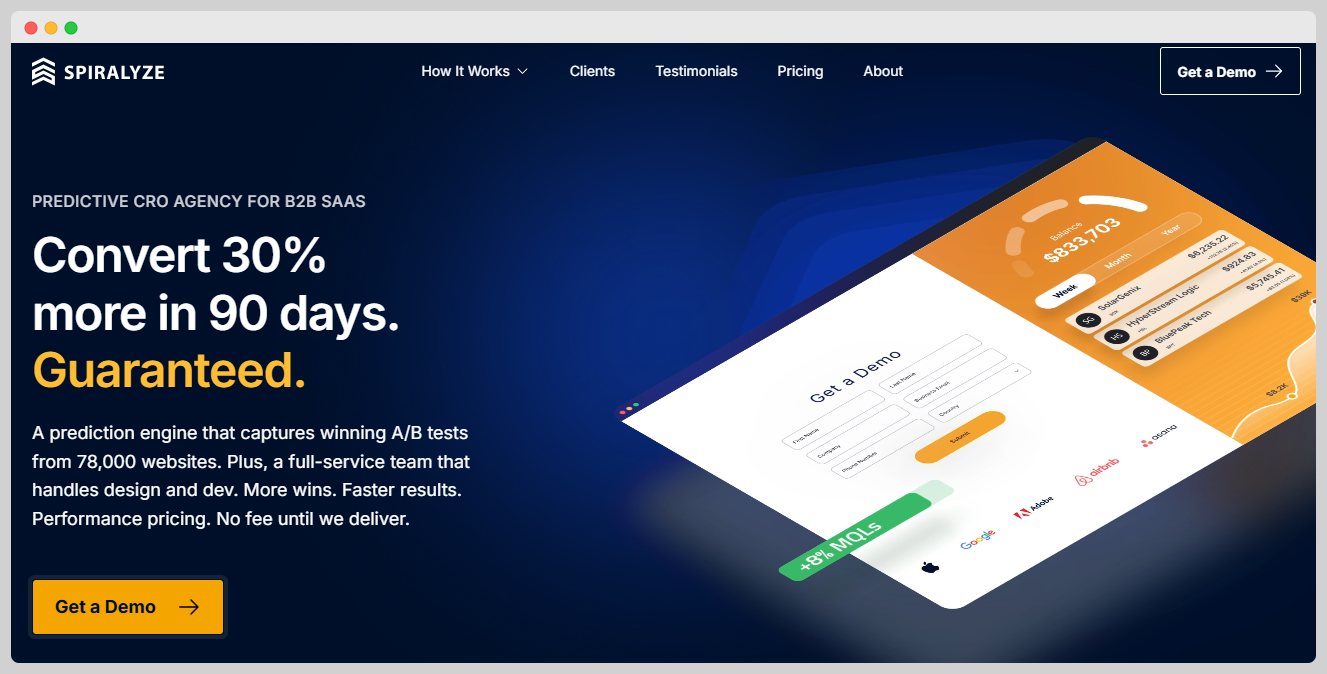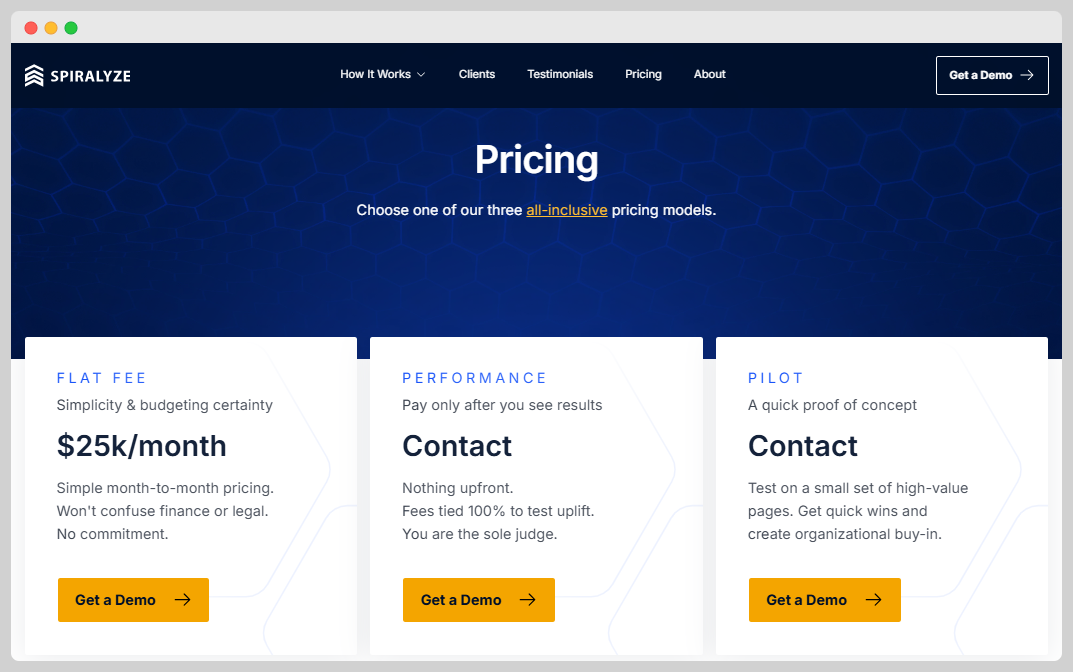
How Sahil Patel Built a $25K/Month Tech-Enabled CRO Service
Who is Sahil Patel?
Sahil Patel, the CEO of Spiralyze, hails from Atlanta and has a background in consulting and healthcare SaaS. He previously founded ER Express and sold it in 2021. Patel is an HBS alumnus who enjoys music and soccer outside of tech.
What problem does Spiralyze solve?
Spiralyze solves the problem of low conversion rates on B2B SaaS websites by using data-driven A/B testing insights gathered from thousands of tests to implement high-impact changes, giving customers a better chance of turning their website visitors into leads or customers, which is crucial for their business growth and marketing ROI.

How did Sahil come up with the idea for Spiralyze?
While leading his previous venture, ER Express, Sahil Patel faced a pressing need to improve user engagement and conversion rates on his company's website. This challenge introduced him to the concept of conversion rate optimization (CRO), and specifically, A-B testing, as a scientific method to enhance user interactions. Recognizing the potential for predictive conversion solutions, he identified the gap where many companies struggled with the complexity and time-consuming nature of designing effective A-B tests.
Having experienced the benefits of predictive optimization firsthand, Patel was motivated to delve deeper into this field. He pursued a unique approach by scraping thousands of websites to uncover successful A-B testing patterns, which could be reapplied across different businesses to improve their conversion rates. This data-driven strategy inspired the foundation of Spiralyze, where hypothesis-backed A-B tests could offer more consistent and reliable improvements in user engagement metrics.
Through analyzing broad data sets, Patel and his team learned which experimental changes consistently resulted in higher conversion rates, allowing them to focus on 'proven winners’. This validation process not only mitigated the risks associated with A-B testing but also provided tangible results more efficiently. This innovative model reduced the inefficiency and high failure rate typical in traditional A-B testing, ultimately leading to a more streamlined process in reaching their targeted conversion improvements.
How did Sahil Patel build the initial version of Spiralyze?
The development of Spiralyze's product involved building a SaaS platform focused on predictive conversion rate optimization (CRO) for B2B companies. They initiated their journey by creating a proprietary web scraping technology that scans approximately 34,000 websites to identify those running A-B tests on client-side or in-browser testing. The tech stack integrates automated visual data capture to compare test variations, enabling Spiralyze to discern winning test patterns across different websites.
Initially, the product was in a rudimentary stage, and the team outlined a vision for transforming it into a sophisticated platform capable of predicting and analyzing test outcomes. Over about two years, they iterated the product to refine its capabilities using machine learning for pattern recognition and enhanced prediction accuracy. The unique insight from their platform is derived from clustering A-B tests and identifying common success elements, termed as "proven winners," which they then implement and test for clients.
Building the product was challenging due to the need for both a robust tech infrastructure for large-scale scraping and processing and a service component that crafts and runs tests for clients. This combination of tech and service required Spiralyze to maintain a large in-house team of around 145 people, including full-stack engineers, designers, and marketers, to manage both the product development and client services efficiently.
What were the initial startup costs for Spiralyze?
- Funding: Spiralyze is a self-funded company.
- Team Size: The company has about 145 people.
How did Sahil launch Spiralyze and get initial traction?
Referral Network
When Spiralyze started, one of the main ways they got their initial customers was through referrals. The company aimed to deliver excellent results for their clients, which encouraged satisfied Chief Marketing Officers (CMOs) to recommend their services to peers. Additionally, because marketing professionals often change jobs every 18 months, those who were happy with Spiralyze's work would bring them into their new companies as well.
Why it worked: By focusing on delivering top-notch service, Spiralyze was able to leverage word-of-mouth marketing effectively. Satisfied customers were more than willing to spread the word, helping the company gain more clients with minimal marketing spend.
Pilot Projects for Engagement
Spiralyze used a 90-day pilot program as a tactic to engage potential clients. They offered a performance-based pricing model where clients would pay based on the conversion lift they achieved after a test period. If Spiralyze didn’t deliver at least a 30% conversion lift, clients wouldn't have to pay.
Why it worked: This approach minimized risk for new clients. By only paying for successful outcomes, potential customers were more likely to try Spiralyze's services, leading to a greater chance of conversion and proving Spiralyze’s confidence in their effectiveness.
Tailored Outreach and Niche Focus
Spiralyze also focused on highly targeted lead acquisition for getting its first customers. By specifically targeting B2B SaaS companies spending approximately $50,000 to $70,000 a month on digital marketing, Spiralyze was able to appeal to a niche market already primed to benefit from conversion rate optimization.
Why it worked: By concentrating efforts on B2B SaaS companies, Spiralyze reached businesses that had substantial marketing budgets and were likely suffering from lower conversion rates, which effectively filled a pain point in this niche market.
What was the growth strategy for Spiralyze and how did they scale?
Client Referrals and Job Transitions
Spiralyze has leveraged client referrals extensively to grow its business. This channel thrives on the strong relationships they foster with current customers. When they deliver successful results, especially for CMOs (Chief Marketing Officers), those clients tend to share their experiences with peers in the industry. This word-of-mouth marketing is particularly effective because CMOs often move jobs every 18 months. When a satisfied CMO joins a new company, they frequently reach out to Spiralyze again, creating a steady stream of business from existing networks.
Why it worked: Referrals are particularly powerful in the B2B sector where trust and proven results carry significant weight. Given the high stakes involved in conversion rate optimization, CMOs prefer vendors who have consistently delivered results, making client referrals a trusted source for new business.
Outbound and Inbound Channels
While Spiralyze explores a variety of outbound and inbound marketing channels, such as advertising, their impact seems less pronounced given the niche nature of their business. Traditional advertising hasn't been a major driver, as noted in their discussions about seeking out different channels without significant traction in advertising.
Why it worked/doesn’t: The effectiveness of these channels is limited due to the specialized nature of their service. Spiralyze found that direct referrals and targeted personal relationships yielded better results than broader advertising efforts.
Proven A/B Testing and Data-Driven Approach
Spiralyze sets itself apart by using a data-driven approach that incorporates predictive modeling with A/B testing. They scrape thousands of websites to identify which A/B strategies have proven successful across multiple cases. By leveraging this data, they design tests for clients that are more likely to succeed based on historical success rates, rather than starting from scratch.
Why it worked: This approach reduces the risk involved in A/B testing, leading to higher success rates. With proprietary technology that identifies "proven winners," Spiralyze can offer performance-based pricing, ensuring clients pay only for successful outcomes. This builds client confidence in their services and attracts businesses focused on measurable results.
Unique Pricing Model
The performance-based pricing model is a significant growth channel. It allows clients to start with a 90-day pilot without incurring costs if Spiralyze doesn't deliver results. This model not only lowers the barrier to entry for potential clients but also aligns Spiralyze's goals with their clients' success.
Why it worked: The low-risk entry and alignment of incentives between Spiralyze and their clients make it an attractive option for businesses looking to optimize their conversion rates with minimal initial investment. This model helps in retaining clients long-term as they see value directly linked to their spending.
What's the pricing strategy for Spiralyze?
Spiralyze adopts a performance-based pricing strategy where clients start with a 90-day pilot for free if no conversion lift is achieved, transitioning to a $25,000 monthly fee thereafter if successful.

What were the biggest lessons learned from building Spiralyze?
- Value Clear Storytelling: Sahil learned that presenting a product without a cohesive narrative didn't connect with the audience. They reworked their approach to include compelling storytelling alongside product demos, helping potential clients see the value of their solutions clearly.
- Embrace Big Changes: Instead of focusing on small tweaks like button colors, Spiralyze found that making significant changes to a website's user experience often led to more substantial improvements in conversion rates. This approach emphasizes the importance of taking bigger risks for more impactful results.
- Leverage Proven Patterns: By analyzing thousands of A-B tests across the web, Spiralyze identified patterns in successful tests. This data-driven approach allows them to implement strategies with higher chances of success, highlighting the importance of informed decision-making in achieving business goals.
- Be Pragmatic About Testing: Spiralyze advocates for ending tests early if they aren't yielding results, as this allows them to focus resources on more promising experiments. This practical approach to A-B testing demonstrates the need to balance rigor with efficiency in dynamic business environments.
- Prioritize Team Versatility: In smaller companies, having hands-on team members who can wear multiple hats is crucial. Sahil emphasizes the importance of hiring adaptable people who can contribute across various functions, ensuring more robust and resilient team dynamics.
Spiralyze Acquisition: How much did Spiralyze sell for and what was the acquisition price?
Spiralyze was acquired by Idera, Inc. in October 2023 for an undisclosed amount. The acquisition aimed to enhance Idera's data-driven marketing capabilities and expand its offerings in conversion rate optimization.
Discover Similar Business Ideas Like Spiralyze
|
|
Idea
|
Revenue
|
|---|---|---|
|
Pixels for Humans
|
Business consulting for socially responsible SaaS startups.
|
$24.2K
monthly
|
|
Ignore No More
|
Marketing agency building un-ignorable brands for SaaS companies.
|
$13K
monthly
|
|
Pickfu
|
Consumer research platform offering instant feedback from targeted audiences.
|
$83.3K
monthly
|
|
Razrtech
|
Neo-banking platform empowering communities and creators globally.
|
$83.3K
monthly
|
|
Attest
|
Consumer insights made easy for data-driven decisions.
|
$550K
monthly
|
|
Evergreen Support
|
"Fractional customer support for busy indie founders."
|
$7K
monthly
|
|
DemandMaven
|
Growth consultancy boosting SaaS companies' strategic growth.
|
$42K
monthly
|
More about Spiralyze:
Who is the owner of Spiralyze?
Sahil Patel is the founder of Spiralyze.
When did Sahil Patel start Spiralyze?
2015
What is Sahil Patel's net worth?
Sahil Patel's business makes an average of $25K/month.
How much money has Sahil Patel made from Spiralyze?
Sahil Patel started the business in 2015, and currently makes an average of $300K/year.

Download the report and join our email newsletter packed with business ideas and money-making opportunities, backed by real-life case studies.

Download the report and join our email newsletter packed with business ideas and money-making opportunities, backed by real-life case studies.

Download the report and join our email newsletter packed with business ideas and money-making opportunities, backed by real-life case studies.

Download the report and join our email newsletter packed with business ideas and money-making opportunities, backed by real-life case studies.

Download the report and join our email newsletter packed with business ideas and money-making opportunities, backed by real-life case studies.

Download the report and join our email newsletter packed with business ideas and money-making opportunities, backed by real-life case studies.

Download the report and join our email newsletter packed with business ideas and money-making opportunities, backed by real-life case studies.

Download the report and join our email newsletter packed with business ideas and money-making opportunities, backed by real-life case studies.















